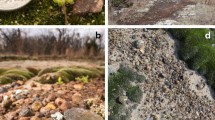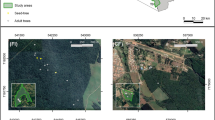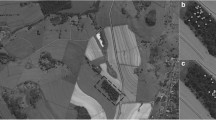Abstract
Genetic constraints may increase the extinction risk in small and isolated plant populations. Introducing foreign genes may restore their genetic variability and fitness, but it could also be harmful, especially when recipient and donor populations have diverged. In such cases, data on genetic relationships and the possible consequences of different patterns of gene flow are essential for effective conservation. We examined five microsatellite loci to study the genetic relationships among three core populations and an isolated peripheral one of the threatened endemic Dianthus guliae Janka. This provided a base for further genetic analyses and experimental pollinations illustrating links between genetic richness and fitness, and the effects of inter-population mating in two contrasting populations (a large core vs. a small peripheral). Microsatellite loci did not show significant deviations from Hardy–Weinberg expectations. However, the peripheral population had lower heterozygosity, a higher inbreeding coefficient, and significant divergence from core units. Fitness and genetic data indicated an enhanced fitness, along with an improved capacity to rebound heterozygosity deficit after occasional selfing, in the core-population compared to the peripheral one. Crossing within-population did not enhance genetic diversity and fitness in the small peripheral unit, while between-population crossing improved its heterozygosity and fitness. Finally, in the study system, current genetic divergence did not preclude heterosis in the small and isolated population after mating with a larger donor unit.




Similar content being viewed by others
References
Abeli T, Gentili R, Mondoni A, Orsenigo S, Rossi G (2014) Effects of marginality on plant population performance. J Biogeogr 41:239–249
Armbruster P, Reed DH (2005) Inbreeding depression in benign and stressful environments. Heredity 95:235–242
Ball SJ, Adams M, Possingham HP, Keller MA (2000) The genetic contribution of single male immigrants to small, inbred populations: a laboratory study using Drosophila melanogaster. Heredity 84:677–684
Bataillon T, Kirkpatrick M (2000) Inbreeding depression due to mildly deleterious mutations in finite populations: size does matter. Genet Res 75:75–81
Becker U, Colling G, Dostal P, Jakobsson A, Matthies D (2006) Local adaptation in the monocarpic perennial Carlina vulgaris at different spatial scales across Europe. Oecologia 150:506–518
Becker U, Dostal P, Jorritsma-Wienk LD, Matthies D (2008) The spatial scale of adaptive population differentiation in a wide-spread, well-dispersed plant species. Oikos 117:1865–1873
Busch JW (2006) Heterosis in an isolated, effectively small, and self-fertilizing population of the flowering plant Leavenworthia alabamica. Evolution 60:184–191
Channell R, Lomolino MV (2000) Dynamic biogeography and conservation of endangered species. Nature 403:84–86
Charlesworth D, Charlesworth B (1987) Inbreeding depression and its evolutionary consequences. Annu Rev Ecol Evol Syst 18: 237–268
Collin CL, Penet L, Shykoff JA (2009) Early inbreeding depression in the sexually dimorphic polymorphic plant Dianthus sylvestris (Caryophyllaceae): effects of selfing and biparental inbreeding among sex morphs. Am J Bot 96:2279–2287
Colling G, Reckinger C, Matthies D (2004) Effects of pollen quantity and quality on reproduction and offspring vigor in the rare plant Scorzonera humilis (Asteraceae). Am J Bot 91:1774–1782
Coombs JS, Letcher BH, Nislow KH (2008) Create: a software to create input files from diploid genotypic data for 52 genetic software programs. Mol Ecol Resour 8:578–580
Corander J, Waldmann P, Sillanpaa MJ (2003) Bayesian analysis of genetic differentiation between populations. Genetics 163:367–374
Cornuet JM, Luikart G (1996) Description and evaluation of two tests for detecting recent bottlenecks. Genetics 144:2001–2014
Donohue K (1998) Effects of inbreeding on traits that influence dispersal and progeny density in Cakile edentula var. lacustris (Brassicaceae). Am J Bot 85:661–668
Dudash MR (1990) Relative fitness of selfed and crossed progeny in a self-compatible, protandrous species, Sabatia angularis L. (Gentianaceae): a comparison in three environments. Evolution 44:1129–1139
Eckert CG, Samis KE, Lougheed SC (2008) Genetic variation across species’ geographical ranges: the central-marginal hypothesis and beyond. Mol Ecol 17:1170–1188
Ezard THG, Travis JMJ (2006) The impact of habitat loss and fragmentation on genetic drift and fixation time. Oikos 114:367–375
Finger A, Kettle CJ, Kaiser-Bunbury CN, Valentin T, Doudee D, Matatiken D, Ghazoul J (2011) Back from the brink: potential for genetic rescue in a critically endangered tree. Mol Ecol 20:3773–3784
Frankham R, Ballou JD, Eldridge MDB, Lacy RC, Ralls K, Dudash MR, Fenster CB (2011) Predicting the probability of outbreeding depression. Conserv Biol 25:465–475
Gargano D (2011) Population biology and conservation of Mediterranean endemics: studies on the rare Dianthus guliae Janka. Fitosociologia 48(s1):163–169
Gargano D, Fenu G, Medagli P, Sciandrello S, Bernardo L (2007) The status of Sarcopoterium spinosum (Rosaceae) at the western periphery of its range: ecological constraints lead to conservation concerns. Isr J Plant Sci 55:1–13
Gargano D, Gullo T, Bernardo L (2009) Do inefficient selfing and inbreeding depression challenge the persistence of the rare Dianthus guliae Janka (Caryophyllaceae)? Influence of reproductive traits on a plant’s proneness to extinction. Plant Species Biol 24:69–76
Gargano D, Gullo T, Bernardo L (2011) Fitness drivers in the threatened Dianthus guliae Janka (Caryophyllaceae): disentangling effect of growth context, maternal influence and inbreeding depression. Plant Biol 13(s1):96–103
Gerst KL, Angert AL, Venable LD (2011) The effect of geographic range position on demographic variability in annual plants. J Ecol 99:591–599
Godefroid S, Piazza C, Rossi G, Buord S, Stevens A-D, Aguraiuja R, Cowell C, Weekley CW, Vogg G, Iriondo JM, Johnson I, Dixon B, Gordon D, Magnanon S, Valentin B, Bjureke K, Koopman R, Vicens M, Virevaire M, Vanderborght T (2011) How successful are plant species reintroductions? Biol Conserv 144:672–682
Goodman SJ (1997) RST CALC: a collection of computer programs for calculating unbiased estimates of genetic differentiation and determining their significance for microsatellite data. Mol Ecol 6:881–885
Hall TA (1999) BioEdit: a user-friendly biological sequence alignment editor and analysis program for Windows 95/98/NT. Nucleic Acids Symp Ser 41:95–98
Hufford KM, Mazer SJ (2003) Plant ecotypes: genetic differentiation in the age of ecological restoration. Trends Ecol Evol 18:147–155
Husband BC, Schemske DW (1996) Evolution of the magnitude and timing of inbreeding depression in plants. Evolution 50:54–70
Ingvarsson PK (2001) Restoration of genetic variation lost—the genetic rescue hypothesis. Trends Ecol Evol 16:62–63
Kanda LL, Fuller TK, Sievert PR, Kellogg RL (2009) Seasonal source-sink dynamics at the edge of a species’ range. Ecology 90:1574–1585
Keller LF, Waller DM (2002) Inbreeding effects in wild populations. Trends Ecol Evol 17:230–241
Lammi A, Siikamäki P, Mustajärvi K (1999) Genetic diversity, population size, and fitness in central and peripheral populations of a rare plant Lychnis viscaria. Conserv Biol 13:1069–1078
Lande R (1995) Mutation and conservation. Conserv Biol 9:782–791
Leimu R, Mutikainen P, Koricheva J, Fisher M (2006) How general are positive relationships between plant population size, fitness, and genetic variation? J Ecol 94:942–952
Leinonen PH, Remington DL, Savolainen O (2011) Local adaptation, phenotypic differentiation, and hybrid fitness in diverged natural populations of Arabidopsis lyrata. Evolution 65:90–107
Lienert J (2004) Habitat fragmentation effects on fitness of plant populations—a review. J Nat Conserv 12:53–72
Lienert J, Fischer M, Diemer M (2002) Local extinctions of the wetland specialist Swertia perennis L. (Gentianaceae) in Switzerland: a revisitation study based on herbarium records. Biol Conserv 103:65–76
Lofflin DL, Kephart SR (2005) Outbreding, seedling establishment, and maladaptation in natural and reintroduced populations of rare and common Silene douglasii (Caryophyllaceae). Am J Bot 92:1691–1700
Lönn M, Prentice HC (2002) Gene diversity and demographic turnover in central and peripheral populations of the perennial herb Gypsophila fastigiata. Oikos 99:489–498
Lopez S, Rousset F, Shaw FH, Shaw RG, Ronce O (2009) Joint effects of inbreeding and local adaptation on the evolution of genetic load after fragmentation. Conserv Biol 23:1618–1627
Luikart G, Cornuet JM (1998) Empirical evaluation of a test for identifying recently bottlenecked populations from allele frequency data. Conserv Biol 12:228–237
Lynch M (1995) A quantitative-genetic perspective on conservation issues. In: Avise J, Hamrick J (eds) Conservation genetics: case histories from nature. Chapman and Hall, New York, pp 471–501
Maruyama T, Fuerst PA (1985) Population bottlenecks and non equilibrium models in population genetics. II. Number of alleles in a small population that was formed by a recent bottleneck. Genetics 111:675–689
McCoy EE, Jones AG, Avise JC (2001) The genetic mating system and tests for cuckoldry in a pipefish species in which males fertilize eggs and brood offspring externally. Mol Ecol 10:1793–1800
Miller JM, Coltman DW (2014) Assessment of identity disequilibrium and its relation to empirical heterozygosity fitness correlations: a meta-analysis. Mol Ecol 23:1899–1909
Moritz C (2002) Strategies to protect biological diversity and the evolutionary processes that sustain it. Syst Bot 51:238–254
Oakley CG, Winn AA (2012) Effects of population size and isolation on heterosis, mean fitness, and inbreeding depression in a perennial plant. New Phytol 196:261–270
Palstra FP, Ruzzante DE (2008) Genetic estimates of contemporary effective population size: what can they tell us about the importance of genetic stochasticity for wild population persistence? Mol Ecol 17:3428–3447
Peakall R, Smouse PE (2006) Genalex 6: genetic analysis in Excel. Population genetic software for teaching and research. Mol Ecol Notes 6:288–295
Pekkala N, Knott KE, Kotiaho JS, Nissinen K, Puurtinen M (2012) The benefits of interpopulation hybridization diminish with increasing divergence of small populations. J Evol Biol 25:2181–2193
Peruzzi L, Gargano D (2006) Dianthus ferrugineus Mill. vs. D. guliae Janka: nomenclatural considerations on the Italian yellow carnation. Taxon 55:781–784
Pickup M, Field D (2013) Source population characteristics affect heterosis following genetic rescue of fragmented plant populations. Proc R Soc B 280:20122058
Reed DH, Frankham R (2003) Correlation between fitness and genetic diversity. Conserv Biol 17:230–237
Richards CM (2000) Inbreeding depression and genetic rescue in a plant metapopulation. Am Nat 155:383–394
Rousset F (2008) Genepop’007: a complete reimplementation of the Genepop software for Windows and Linux. Mol Ecol Resour 8:103–106
Shea KL, Furnier GR (2002) Genetic variation and population structure in central and isolated populations of balsam fir, Abies balsamea (Pinaceae). Am J Bot 89:783–791
Sheridan PM, Karowe DN (2000) Inbreeding, outbreding, and heterosis in the yellow pitcher plant, Sarracenia flava (Sarraceniaceae), in Virginia. Am J Bot 87:1628–1633
Smulders MJM, Rus-Kortekaas W, Vosman B (2000) Microsatellite markers useful throughout the genus Dianthus. Genome 43:208–210
Tallmon DA, Luikart G, Waples RS (2004) The alluring simplicity and complex reality of genetic rescue. Trends Ecol Evol 19:489–496
Thompson JD (2005) Plant evolution in the Mediterranean. Oxford University Press, Oxford
Tutin TG, Walters SM (1993) Dianthus L. In: Tutin TG, Burges NA, Chater AO, Edmondson JR, Heywood VH, Moore DM, Valentine DH, Walters SM, Webb DA (eds) Flora Europaea 1, 2nd edn. Cambridge University Press, Cambridge, pp 227–246
Walker D, Porter BA, Avise JC (2002) Genetic parentage assessment in the crayfish Orconectes placidus, a highfecundity invertebrate with extended maternal brood care. Mol Ecol 11:2115–2122
Weir BS, Cockerham CC (1984) Estimating F-statistics for the analysis of population structure. Evolution 38:1358–1370
Whiteley AR, Fitzpatrick SW, Funk WC, Tallmon DA (2015) Genetic rescue to the rescue. Trends Ecol Evol 30:42–49
Willi Y, Fischer M (2005) Genetic rescue in interconnected populations of small and large size of the self-incompatible Ranunculus reptans. Heredity 95:437–443
Willi Y, Van Kleunen M, Dietrich S, Fischer M (2007) Genetic rescue persists beyond first-generation outbreeding in small populations of a rare plant. Proc R Soc B 274:2357–2364
Woodworth LM, Montgomery ME, Briscoe DA, Frankham R (2002) Rapid genetic deterioration in captive populations: causes and conservation implications. Conserv Genet 3:277–288
Wright LI, Tregenza T, Hosken DJ (2008) Inbreeding, inbreeding depression and extinction. Conserv Genet 9:833–843
Young AG, Boyle T, Brown T (1996) The population genetic consequences of habitat fragmentation for plants. Trends Ecol Evol 11:413–41418
Acknowledgments
The authors are grateful to Teresa Gullo, Vittoria Tropea, Giovanni Borda and Luigi Spina for support in experimental pollinations, and Antonio de Giuseppe for help in cultivating plants. The researches the paper refers to are part of the project ‘Sistematica e conservazione della flora della Calabria: indagini su diversità, ecologia, e rischio d’estinzione in popolazioni, specie e comunità vegetali’ supported by Ministero dell’Istruzione, dell’Università e della Ricerca (ex MURST 60 %). Finally, we thank Kevin O’Connell (O’Connell’s School) for linguistic improvements.
Author information
Authors and Affiliations
Corresponding author
Electronic supplementary material
Below is the link to the electronic supplementary material.
Rights and permissions
About this article
Cite this article
Gargano, D., Pellegrino, G. & Bernardo, L. Genetic and fitness consequences of interpopulation mating in Dianthus guliae Janka: conservation implications for severely depleted and isolated plant populations. Conserv Genet 16, 1127–1138 (2015). https://doi.org/10.1007/s10592-015-0727-z
Received:
Accepted:
Published:
Issue Date:
DOI: https://doi.org/10.1007/s10592-015-0727-z




